Epiphany
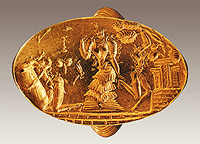 One important Minoan ritual was Epiphany, that is the appearance
of the goddess before the religious community.
It involved appeals, hymns
and ecstatic dances.
The Epiphany scene is very popular in Minoan iconography.
In such representations, the deity descends from the sky, her hair waving in the air.
Alternatively, she is depicted receiving the supplications of the faithful in a sacred
enclosure close to a pedestal or a sacred tree. Some representations show a priestess-goddess
on a swing, leaning on trees or columns. On a clay model from Agia Triada the priestess-goddess
is swinging between two pillars on which two doves are perched. On feast-days the priestess-queen
was carried around on a palanquin seat by her subjects. The palanquin had acquired a
symbolic, sacred meaning. A clay model of a palanquin was found at Knossos along with other
models of sacred objects. There is also the view that the alabaster throne in the
palace of Knossos may not have been meant for the king but for the priestess-queen
who impersonated the goddess flanked by two griffins, which would
make sense in view of the theocratic character of the Minoan political system.
One important Minoan ritual was Epiphany, that is the appearance
of the goddess before the religious community.
It involved appeals, hymns
and ecstatic dances.
The Epiphany scene is very popular in Minoan iconography.
In such representations, the deity descends from the sky, her hair waving in the air.
Alternatively, she is depicted receiving the supplications of the faithful in a sacred
enclosure close to a pedestal or a sacred tree. Some representations show a priestess-goddess
on a swing, leaning on trees or columns. On a clay model from Agia Triada the priestess-goddess
is swinging between two pillars on which two doves are perched. On feast-days the priestess-queen
was carried around on a palanquin seat by her subjects. The palanquin had acquired a
symbolic, sacred meaning. A clay model of a palanquin was found at Knossos along with other
models of sacred objects. There is also the view that the alabaster throne in the
palace of Knossos may not have been meant for the king but for the priestess-queen
who impersonated the goddess flanked by two griffins, which would
make sense in view of the theocratic character of the Minoan political system.
Ritual Dance
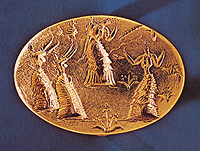 In much Minoan iconography, female figures are represented in ecstatic dance.
Almost all the musical events and dances had a sacred character as religious symbols
appear in all these scenes. Dance brought on ecstasy, and in this way contributed to
Epiphanic visions.
Ritual dances often took place in sacred groves. On a gold sealing ring from Isopata four
priestesses are dancing bare-breasted. On a fruitstand from Phaistos two women holding
flowers are dancing. A clay model from a tomb in Kamilari represents four men in a
sacred circular dance. The sacredness of the scene is implied by the consecration horns
identifiable on the base of the model.
In much Minoan iconography, female figures are represented in ecstatic dance.
Almost all the musical events and dances had a sacred character as religious symbols
appear in all these scenes. Dance brought on ecstasy, and in this way contributed to
Epiphanic visions.
Ritual dances often took place in sacred groves. On a gold sealing ring from Isopata four
priestesses are dancing bare-breasted. On a fruitstand from Phaistos two women holding
flowers are dancing. A clay model from a tomb in Kamilari represents four men in a
sacred circular dance. The sacredness of the scene is implied by the consecration horns
identifiable on the base of the model.
Worship Postures

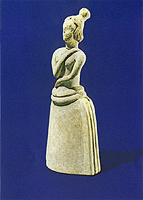 Many of these statuettes and the religious scenes represent a specific position of prayer.
The worshippers appear before the sanctuary or the vision of a goddess
with their torsos inclined backwards, and one hand on their heads.
Other prayer postures indicated in representations of worship include raised
hands, outstretched arms and crouching.
These postures pertained to supplications, prayers and devotion to the deity.
They may represent the successive phases of ritual movements during which hands are extended
and then drawn back close to the body.
Many of these statuettes and the religious scenes represent a specific position of prayer.
The worshippers appear before the sanctuary or the vision of a goddess
with their torsos inclined backwards, and one hand on their heads.
Other prayer postures indicated in representations of worship include raised
hands, outstretched arms and crouching.
These postures pertained to supplications, prayers and devotion to the deity.
They may represent the successive phases of ritual movements during which hands are extended
and then drawn back close to the body.
Blood Sacrifices
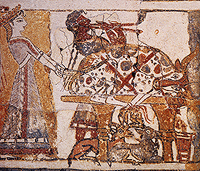 Large and small animals were sacrificed to the goddess.
The painted larnaka of Agia Triada, a unique find, provides important information concerning
sacrificial ritual. On side shows a sacrificed bull tied to an altar.
The blood running from its neck is collected in a vessel. Smaller animals are waiting
to be sacrificed while a musician plays the flute. The blood is carried in vases passed
through a wooded rod which a priestess holds. A second priestess pours the blood into
a larger vase between two double axes.
The most sacred moment of the blood sacrifice is accompanied by music played by a
seven-chord lyre. Some sanctuaries, such as the one at the home of the priest of
Knossos, had special installations for the collection of blood;
It ran from the base of the altar
down into a drain. It is likely that communion took place from the altar
and the hides of the sacrificed animals were offered to the sanctuary.
Large and small animals were sacrificed to the goddess.
The painted larnaka of Agia Triada, a unique find, provides important information concerning
sacrificial ritual. On side shows a sacrificed bull tied to an altar.
The blood running from its neck is collected in a vessel. Smaller animals are waiting
to be sacrificed while a musician plays the flute. The blood is carried in vases passed
through a wooded rod which a priestess holds. A second priestess pours the blood into
a larger vase between two double axes.
The most sacred moment of the blood sacrifice is accompanied by music played by a
seven-chord lyre. Some sanctuaries, such as the one at the home of the priest of
Knossos, had special installations for the collection of blood;
It ran from the base of the altar
down into a drain. It is likely that communion took place from the altar
and the hides of the sacrificed animals were offered to the sanctuary.
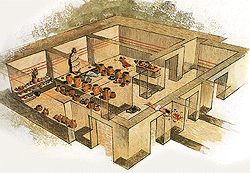 Today there is clear evidence that human sacrifice took place in Minoan Crete.
The most important piece of evidence comes from a relatively recent find from
the peak sanctuary at Anemospilia near Archanes. In this building a skeleton of a young
person killed by a knife was found. The person must have been sacrificed a little
before the collapse of the building, in the Middle Minoan IIIA period (1750-1700 BC).
At first this interpretation was rejected as it was judged
incompatible with the character of Minoan society thitherto considered
a peaceful, non-violent society.
Today there is clear evidence that human sacrifice took place in Minoan Crete.
The most important piece of evidence comes from a relatively recent find from
the peak sanctuary at Anemospilia near Archanes. In this building a skeleton of a young
person killed by a knife was found. The person must have been sacrificed a little
before the collapse of the building, in the Middle Minoan IIIA period (1750-1700 BC).
At first this interpretation was rejected as it was judged
incompatible with the character of Minoan society thitherto considered
a peaceful, non-violent society.
Bloodless Offerings
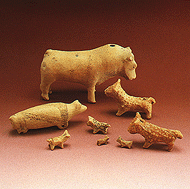 Despite the fact that blood sacrifices undoubtedly signified the greatest respect
for the deity, other offerings were commonly made.
Offerings of animal effigies substituted live victims and
human effigies indicated the devotion of the faithful to the sanctuary.
There is a great variety of
ritual objects, such as priestly garments, thrones,
altars and palanquins of the priestess-goddess.
The offering of model temples was probably a
substitute for the building of sanctuaries.
Agricultural produce, particularly wine and honey, were commonly offered too.
Honey is frequently referred to in the Linear B tablets from Knossos
as an offering to Eileithyia, the goddess of childbirth.
Despite the fact that blood sacrifices undoubtedly signified the greatest respect
for the deity, other offerings were commonly made.
Offerings of animal effigies substituted live victims and
human effigies indicated the devotion of the faithful to the sanctuary.
There is a great variety of
ritual objects, such as priestly garments, thrones,
altars and palanquins of the priestess-goddess.
The offering of model temples was probably a
substitute for the building of sanctuaries.
Agricultural produce, particularly wine and honey, were commonly offered too.
Honey is frequently referred to in the Linear B tablets from Knossos
as an offering to Eileithyia, the goddess of childbirth.
Incense
 During religious ceremonies the priests would burn aromatic substances.
Incensories similar to the one depicted in a fresco of Thera were found in
sacred buildings but also in tombs. It is likely that opium was used in certain
ceremonies for achieving hypnosis and ecstasy.
During religious ceremonies the priests would burn aromatic substances.
Incensories similar to the one depicted in a fresco of Thera were found in
sacred buildings but also in tombs. It is likely that opium was used in certain
ceremonies for achieving hypnosis and ecstasy.
Magic
In addition to religious ceremonies, the Minoans also took part in popular magic rituals. Spells used to fight illness and other suffering were also known in Egypt. A magic formula inscribed on a cup from Knossos promised the release of magic power when the cup is inverted. Rare healing herbs systematically collected in Crete were still well-known in Antiquity.